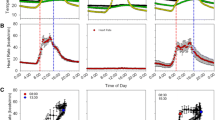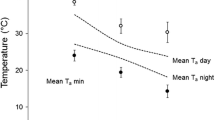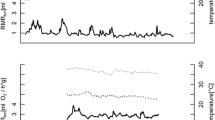Abstract
Much of our knowledge of the thermoregulation of endotherms has been obtained from species inhabiting cold and temperate climates, our knowledge of the thermoregulatory physiology of tropical endotherms is scarce. We studied the thermoregulatory physiology of a small, tropical mammal, the large treeshrew (Tupaia tana, Order Scandentia) by recording the body temperatures of free-ranging individuals, and by measuring the resting metabolic rates of wild individuals held temporarily in captivity. The amplitude of daily body temperature (~ 4 °C) was higher in treeshrews than in many homeothermic eutherian mammals; a consequence of high active-phase body temperatures (~ 40 °C), and relatively low rest-phase body temperatures (~ 36 °C). We hypothesized that high body temperatures enable T. tana to maintain a suitable gradient between ambient and body temperature to allow for passive heat dissipation, important in high-humidity environments where opportunities for evaporative cooling are rare. Whether this thermoregulatory phenotype is unique to Scandentians, or whether other warm-climate diurnal small mammals share similar thermoregulatory characteristics, is currently unknown.



Similar content being viewed by others
Abbreviations
- BMR:
-
Basal metabolic rate
- C dry :
-
Dry thermal conductance (mO2·°C−1·h−1)
- C wet :
-
Wet thermal conductance (mO2·°C−1·h−1)
- EHL:
-
Evaporative heat loss (W)
- EWL:
-
Evaporative water loss (mg·g−1·h−1)
- HI:
-
Heterothermy index
- MHP:
-
Metabolic heat production (W)
- RMR:
-
Resting metabolic rate
- T a :
-
Ambient temperature (respirometer temperature or environmental temperature)
- T b :
-
Core body temperature
- T lc :
-
Lower limit of the TNZ
- T sub :
-
Subcutaneous temperature
- TNZ:
-
Thermoneutral zone
- O2 :
-
Volumetric rate of oxygen consumed by the animal (mO2·h−1)
References
Alagaili AN, Bennett NC, Mohammed OB, Zalmout IS, Boyles JG (2017) Body temperature patterns of a small endotherm in an extreme desert environment. J Arid Environ 137:16–20. https://doi.org/10.1016/j.jaridenv.2016.10.010
Angilletta MJ Jr, Cooper BS, Schuler MS, Boyles JG (2010) The evolution of thermal physiology in endotherms. Front Biosci 2:861–881
Bartholomew GA (1972) Body temperature and energy metabolism. In: Gordon MS, Bartholomew GA, Grinnell AD, Jorgensen CB, White FN (eds) Animal physiology: principles and adaptations, Second edn. Macmillan Publishing Co., Inc., New York, pp 298–368
Bennett AF, Ruben JA (1979) Endothermy and activity in vertebrates. Science 206(4419):649–654
Bennie JJ, Duffy JP, Inger R, Gaston KJ (2014) Biogeography of time partitioning in mammals. PNAS 111(38):13727–13732. https://doi.org/10.1073/pnas.1216063110
Bieber C, Cornils JS, Hoelzl F, Giroud S, Ruf T (2017) The costs of locomotor activity? Maximum body temperatures and the use of torpor during the active season in edible dormice. J Comp Physiol B 187(5):803–814. https://doi.org/10.1007/s00360-017-1080-y
Boyles JG, Smit B, McKechnie AE (2011) A new comparative metric for estimating heterothermy in endotherms. Physiol Biochem Zool 84(1):115–123
Boyles JG, Thompson AB, McKechnie AE, Malan E, Humphries MM, Careau V (2013) A global heterothermic continuum in mammals. Glob Ecol Biogeogr 22(9):1029–1039. https://doi.org/10.1111/geb.12077
Brodie JF, Strimas-Mackey M, Mohd-Azlan J, Granados A, Bernard H, Giordano AJ, Helmy OE (2017) Lowland biotic attrition revisited: body size and variation among climate change ‘winners’ and ‘losers’. Proc R Soc B 284(1847):20162335. https://doi.org/10.1098/rspb.2016.2335
Burnham K, Anderson D (2002) Model Selection and Multimodal Inference: A Practical Information-Theoretic Approach, 2nd edn. Springer-Verlag, New York, NY
Clarke A, O’Connor MI (2014) Diet and body temperature in mammals and birds. Glob Ecol Biogeogr 23:1000–1008. https://doi.org/10.1111/geb.12185
Crawley MJ (2007) The R Book. John Wiley & Sons Ltd, Chichester
Crompton AW, Taylor CR, Jagger JA (1978) Evolution of homeothermy in mammals. Nature 272:333–336
de Bruyn M, Stelbrink B, Morley RJ, Hall R, Carvalho GR, Cannon CH, van den Bergh G, Meijaard E, Metcalfe I, Boitani L, Maiorano L, Shoup R, von Rintelen T (2014) Borneo and Indochina are Major Evolutionary Hotspots for Southeast Asian Biodiversity. Syst Biol 63(6):879–901. https://doi.org/10.1093/sysbio/syu047
Emmons LH (2000) Tupai: A Field Study of Bornean Treeshrews. University of California Press, Los Angeles
Fritz SA, Bininda-Emonds ORP, Purvis A (2009) Geographical variation in predictors of mammalian extinction risk: big is bad, but only in the tropics. Ecol Lett 12(6):538–549. https://doi.org/10.1111/j.1461-0248.2009.01307.x
Gerson AR, Smith EK, Smit B, McKechnie AE, Wolf BO (2014) The impact of humidity on evaporative cooling in small desert birds exposed to high air temperatures. Physiol Biochem Zool 87(6):782–795
Grigg GC, Beard LA (2000) Hibernation by echidnas in mild climates: hints about the evolution of endothermy? In: Heldmaier G, Klingenspor M (eds) Life in the Cold: Eleventh Internation Hibernation Symposium. Springer, New York, pp 5–20
Heinrich B (1977) Why have some animals evolved to regulate a high body temperature? Am Nat 111:623–640
Huey RB, Kearney MR, Krockenberger A, Holtum JAM, Jess M, Williams SE (2012) Predicting organismal vulnerability to climate warming: roles of behaviour, physiology and adaptation. Phil Trans R Soc B 367(1596):1665–1679
Hughes AC (2017) Understanding the drivers of Southeast Asian biodiversity loss. Ecosphere 8(1):e01624. https://doi.org/10.1002/ecs2.1624
Humphries MM, Careau V (2011) Heat for nothing or activity for free? Evidence and implications of activity-thermoregulatory heat substitution. Integr Comp Biol 51(3):419–431. https://doi.org/10.1093/icb/icr059
Jones KE, Bielby J, Cardillo M, Fritz SA, O’Dell J, Orme CDL, Safi K, Sechrest W, Boakes EH, Carbone C (2009) PanTHERIA: a species-level database of life history, ecology, and geography of extant and recently extinct mammals. Ecology 90(9):2648–2648
Kobbe S, Nowack J, Dausmann K (2014) Torpor is not the only option: seasonal variations of the thermoneutral zone in a small primate. J Comp Physiol B 184(6):789–797. https://doi.org/10.1007/s00360-014-0834-z
Levesque DL, Lovegrove BG (2014) Increased homeothermy during reproduction in a basal placental mammal. J Exp Biol 217:1535–1542
Levesque DL, Lobban KD, Lovegrove BG (2014) Effects of reproductive status and high ambient temperatures on the body temperature of a free-ranging basoendotherm. J Comp Physiol B 184:1041–1053. https://doi.org/10.1007/s00360-014-0858-4
Levesque DL, Nowack J, Stawski C (2016) Modelling mammalian energetics: the heterothermy problem. Clim Change Resp 3(1):7. https://doi.org/10.1186/s40665-016-0022-3
Levesque DL, Menzies AK, Landry-Cuerrier M, Larocque G, Humphries MM (2017) Embracing heterothermic diversity: non-stationary waveform analysis of temperature variation in endotherms. J Comp Physiol B 187(5):749–757. https://doi.org/10.1007/s00360-017-1074-9
Lovegrove BG (2000) The zoogeography of mammalian basal metabolic rate. Am Nat 156(2):201–219
Lovegrove BG (2017) A phenology of the evolution of endothermy in birds and mammals. Biol Rev 92(2):1213–1240. https://doi.org/10.1111/brv.12280
Lovegrove BG, Génin F (2008) Torpor and hibernation in a basal placental mammal, the Lesser Hedgehog Tenrec, Echinops telfairi. J Comp Physiol B 178:691–698
Lovegrove BG, Canale CI, Levesque DL, Fluch G, Řeháková-Petrů M, Ruf T (2014) Are tropical small mammals physiologically vulnerable to Arrhenius effects and climate change? Physiol Biochem Zool 87(1):30–45. https://doi.org/10.1086/673313
MacArthur RA, Campbell KL (1994) Heat increment of feeding and its thermoregulatory benefit in the muskrat (Ondatra zibethicus). J Comp Physiol B 164(2):141–146. https://doi.org/10.1007/bf00301656
Malan A (1996) The origins of hibernation: a reappraisal. In: Geiser F, Hulbert A, Nicol S (eds) Adaptations to the cold. University of New England Press, Armidale, NSW, pp 1–6
Martin R (1968) Reproduction and Ontogeny in tree-shrews (Tupaia belangeri), with reference to their general behaviour and taxonomic relationships. Zeitschrift für Tierpsychologie 25(4):409–495
Mazerolle MJ (2013) AICcmodavg: Model selection and multimodel inference based on (Q)AIC(c)
McCain CM, King SRB (2014) Body size and activity times mediate mammalian responses to climate change. Glob Change Biol 20(6):1760–1769. https://doi.org/10.1111/gcb.12499
McKechnie AE, Lovegrove BG (2001) Thermoregulation and the energetic significance of clustering behavior in the white-backed mousebird (Colius colius). Physiol Biochem Zool 74(2):238–249
McNab BK (1980) On estimating thermal conductance in endotherms. Physiol Zool 53:145–156
Mitchell D, Snelling EP, Hetem RS, Maloney SK, Strauss WM, Fuller A (2018) Revisiting concepts of thermal physiology: predicting responses of mammals to climate change. J Anim Ecol Early View. https://doi.org/10.1111/1365-2656.12818
Montagna W, Yun JS, Silver AF, Quevedo WC (1962) The skin of primates. XIII. The skin of the tree shrew (Tupaia glis). Am J Phys Anthropol 20(4):431–439. https://doi.org/10.1002/ajpa.1330200404
Munshi-South J, Emmons LH, Bernard H (2007) Behavioral monogamy and fruit availability in the large treeshrew (Tupaia tana). In: Sabah (ed), Malaysia J Mammal 88 (6):1427–1438. https://doi.org/10.1644/06-MAMM-A-295R1.1
Mzilikazi N, Masters JC, Lovegrove BG (2006) Lack of torpor in free-ranging southern lesser galagos, Galago moholi: ecological and physiological considerations. Folia Primatol 77(6):465–476
Naya DE, Spangenberg L, Naya H, Bozinovic F (2013) How does evolutionary variation in basal metabolic rates arise? A statistical assessment and a mechanistic model. Evolution 67(5):1463–1476
Nowack J, Mzilikazi N, Dausmann KH (2010) Torpor on demand: heterothermy in the non-lemur primate Galago moholi. PLoS ONE 5(5):e10797. https://doi.org/10.1371/journal.pone.0010797
Orme D (2013) The caper package: comparative analysis of phylogenetics and evolution in R. 3.3.1 edn.
Pinheiro J, Bates D, DebRoy S, Sarkar D, R Development Core Team (2013) nlme: Linear and Nonlinear Mixed Effects Models. R package version 3.pp 1–108
Quintero I, Wiens JJ (2013) Rates of projected climate change dramatically exceed past rates of climatic niche evolution among vertebrate species. Ecol Lett 16(8):1095–1103
R Development Core Team (2011) R: a language and environment for statistical computing. R Foundation for Statistical Computing, Vienna
Refinetti R (1997) The effects of ambient temperature on the body temperature rhythm of rats, hamsters, gerbils, and tree shrews. J Therm Biol 22(4–5):281–284
Riek A, Geiser F (2013) Allometry of thermal variables in mammals: consequences of body size and phylogeny. Biol Rev 88:564–572
Sargis EJ (2004) New views on tree shrews: the role of tupaiids in primate supraordinal relationships. Evol Anthropol: Issues News Rev 13(2):56–66
Scholander PF, Hock R, Walters V, Irving L (1950) Adaptation to cold in arctic and tropical mammals and birds in relation to body temperature, insulation, and basal metabolic rate. Biol Bull 99(2):259–271
Sheriff M, Williams C, Kenagy G, Buck C, Barnes B (2012) Thermoregulatory changes anticipate hibernation onset by 45 days: data from free-living arctic ground squirrels. J Comp Physiol B 182(6):841–847. https://doi.org/10.1007/s00360-012-0661-z
Speakman JR, Krol E (2010) Maximal heat dissipation capacity and hyperthermia risk: neglected key factors in the ecology of endotherms. J Anim Ecol 79(4):726–746. https://doi.org/10.1111/j.1365-2656.2010.01689.x
Swanson DL, McKechnie AE, Vézina F (2017) How low can you go? An adaptive energetic framework for interpreting basal metabolic rate variation in endotherms. J Comp Physiol B 187(8):1039–1056. https://doi.org/10.1007/s00360-017-1096-3
Tattersall GJ, Sinclair BJ, Withers PC, Fields PA, Seebacher F, Cooper CE, Maloney SK (2012) Coping with thermal challenges: physiological adaptations to environmental temperatures. Compr Physiol 2:2151–2202. https://doi.org/10.1002/cphy.c110055
Tuen AA, Sayok AK, Das I, Noweg GT, Laman CJ, Met L Applying the HCVF toolkit to assess the conservation value of Gunung Singai, Sarawak, East Malaysia. In: Proceedings of 3rd RIMBA Symposium on Sustaining Livelihood through Prudent Utilization and Management of Natural Resources, Institute of Biodiversity & Environmental Conservation, Universiti Malaysia Sarawak, 2014. pp 52–62
Wallace AR (1890) The Malay Archipelago: the land of the orang-utan and the bird of paradise: a narrative of travel, with studies of man and nature. Macmillan
Wang J, Xu X-L, Ding Z-Y, Mao R-R, Zhou Q-X, Lv L-B, Wang L-P, Wang S, Zhang C, Xu L (2013) Basal physiological parameters in domesticated tree shrews (Tupaia belangeri chinensis). Zool Res 34(2):69–74
Welman S, Tuen AA, Lovegrove BG (2017) Searching for the Haplorrhine heterotherm: field and laboratory data of free-ranging tarsiers. Frontiers in Physiology 8:745. https://doi.org/10.3389/fphys.2017.00745
White CR, Portugal SJ, Martin GR, Butler PJ (2006) Respirometry: Anhydrous Drierite equilibrates with carbon dioxide and increases washout times. Physiol Biochem Zool 79(5):977–980
White CR, Blackburn TM, Seymour RS (2009) Phylogenetically informed analysis of the allometry of mammalian basal metabolic rate supports neither geometric nor quarter-power scaling. Evolution 63(10):2658–2667. https://doi.org/10.1111/j.1558-5646.2009.00747.x
Withers PC (1992) Comparative animal physiology. Saunders College Pub., Fort Worth
Withers PC (2001) Design, calibration and calculation for flow-through respirometry systems. Aust J Zool 49(4):445–461
Withers PC Free ranging body temperatures of mammals: Are there still phylogenetic effects? 12th International Mammalogical Congress, Perth, Western Australia, 2017
Withers PC, Cooper CE, Maloney SK, Bozinovic F, Cruz-Neto AP (2016) Ecological and environmental physiology of mammals. Oxford University Press
Wolf BO, Coe BH, Gerson AR, McKechnie AE (2017) Comment on an analysis of endotherm thermal tolerances: systematic errors in data compilation undermine its credibility. Proc R Soc B 284 (1855). https://doi.org/10.1098/rspb.2016.2523
Wu J, Yonezawa T, Kishino H (2017) Rates of molecular evolution suggest natural history of life history traits and a post-K-Pg nocturnal bottleneck of placentals. Curr Biol 27(19):3025–3033.e3025. https://doi.org/10.1016/j.cub.2017.08.043
Zhu WL, Zhang L, Wang ZK (2010) Thermogenic characteristics and evaporative water loss in the tree shrew (Tupaia belangeri). J Therm Biol 35(6):290–294. https://doi.org/10.1016/j.jtherbio.2010.06.005
Acknowledgements
We wish to thank the following individuals and institutions for their assistance: the Bidayuh communities of Kampung Tanjong Bowang and Kampung Barieng, Singai, Bau District, for the use of their forest; Mary Buloh Balang, Shaun Welman, Cindy Peter, Cecilia Emang Ajeng, Matthew Jenang, and Yap Pui Kwan, for their assistance in the field; and Michelle Bassis for help with the body temperature/activity database.
Author information
Authors and Affiliations
Contributions
DLL, AAT and BGL conceived and designed the study. DLL and AAT secured the permits and performed the data collection. DLL analysed the data and drafted the manuscript. All authors contributed critically to the drafts and gave final approval for publication.
Corresponding author
Ethics declarations
Ethical standards
All procedures involving the use of animals were approved by the Animal Research Ethics Committee of the University of Kwa-Zulu Natal (061/13/Animal), Sarawak Forestry Department and the Malaysian Ministry of Natural Resources (permit no. NCCD.907.4.4(9)-223, and NCCD.907.4.4(JLD.13)-227), and comply with all local laws. The research was supported by the Malaysian Ministry of Higher Education (FRGS/1/2013/ST03/UNIMAS/01/2), the UNIMAS Postdoctoral Scheme (DLL), and incentive grants from the University of KwaZulu-Natal and the National Research Foundation (South Africa) to BGL.
Additional information
Communicated by G. Heldmaier.
Electronic supplementary material
Below is the link to the electronic supplementary material.
Rights and permissions
About this article
Cite this article
Levesque, D.L., Tuen, A.A. & Lovegrove, B.G. Staying hot to fight the heat-high body temperatures accompany a diurnal endothermic lifestyle in the tropics. J Comp Physiol B 188, 707–716 (2018). https://doi.org/10.1007/s00360-018-1160-7
Received:
Revised:
Accepted:
Published:
Issue Date:
DOI: https://doi.org/10.1007/s00360-018-1160-7




